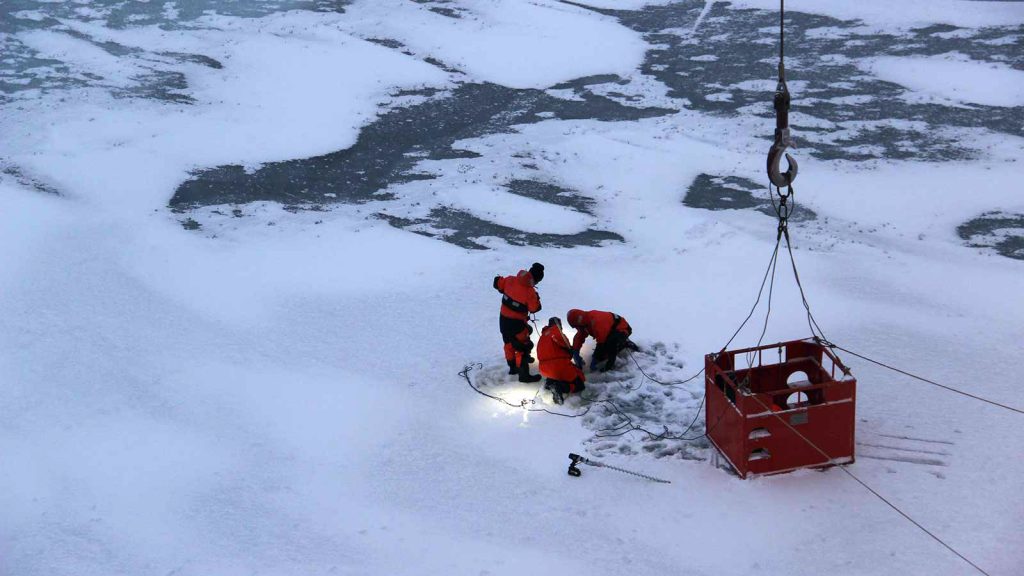
Still collecting new experiences after 30 years of going to sea—in this case, Mike, Christian, and Marcel dig NUI out from under the ice to end NUI Dive 13. The cage next to them is how they got on and off of the ice. (photo by Chris German, Woods Hole Oceanographic Institution)
Well, Dive 13 happened, and the vehicle is back on deck. That’s the short version.
As I spent time on ice watch yesterday (Friday), and as the snow blew past and the temperature dropped below -5°C (23°F), I had time to reflect on some of the crazy things I have done with robots during my career.
Like fishing for the U.K.’s AUTOSUB-1 autonomous vehicle in a Scottish sea loch one November because it had rained so hard during the dive that the salinity at the sea surface had changed. That changed the density of the surface water so that when the robot came back up, it couldn’t make it the last few feet. So, as the rain continued to fall, I climbed into the ship’s small boat with a boat hook and go fish it out.
Or the time I finally got to go to sea with the U.K.’s Isis remotely operated vehicle, sister vehicle to WHOI’s Jason, and got it caught on a mooring at more than 2,000 meters (6,600 feet) depth between South Georgia and the South Sandwich Islands in the Southern Ocean. Or, on the very next cruise a few weeks later, when we sailed out of Puerto Montt, Chile, and experienced a magnitude 9 earthquake (the 4th biggest in recorded history) and subsequent tsunami (we were only 30 miles offshore but in very deep water over the Chile Trench so didn’t notice it pass) and then had our deep-diving autonomous underwater vehicle ABE implode on us. That was quite the week.
Oh, and then there was 2013, when we were diving with the Nereus Hybrid-ROV (a precursor to NUI) and found ourselves entangled in a cable at more than 5000 meters (16,000 feet) depth.
So, what had me thinking such thoughts? Well, right after we let NUI start its dive, it slid gently under some loose ice just a few tens of meters from the ship before coming to rest nestled against the underside of the ice, its lights shining brightly. And there it sat.
Meanwhile, on the other side of the ship, Kevin and the ice camp party were going about their research. Since NUI wasn’t in any immediate danger, but we would need to move the ship to get NUI back, the only obvious thing to do was to have the ice-team move up completion of their work and then go get our robot back.
First, Captain Schwarze moved the ship across the open water that we had cleared for the launch and then we used our navigation system to locate precisely where NUI was—even though we could see its lights shining through the ice, it’s good to have the numbers. Then Christian and Marcel from the ice physics group, both fresh back from the day’s ice camp, plus Mike from the NUI team were lifted across onto the ice in a cage specifically built for that purpose.
Once they were on the ice, they cut a small hole directly over NUI, attached a line and floats, and passed the line back to the ship. Then, slowly and carefully, we teased NUI out from under the ice and back out to open water. By just after 8:00 p.m., the vehicle was back on deck. It was a long day, but at least we avoided the German definition of AUV that I had learned as the day progressed: Aussetzung und Verlieren (Suspension and Loss).
Next up, we plan to spend the weekend looking for some new, deep vent-sites using the ship’s CTD and OFOS camera systems at the bottom of the Gakkel Ridge. And we are aiming to get little NUI back on-line and in the water early next week.

